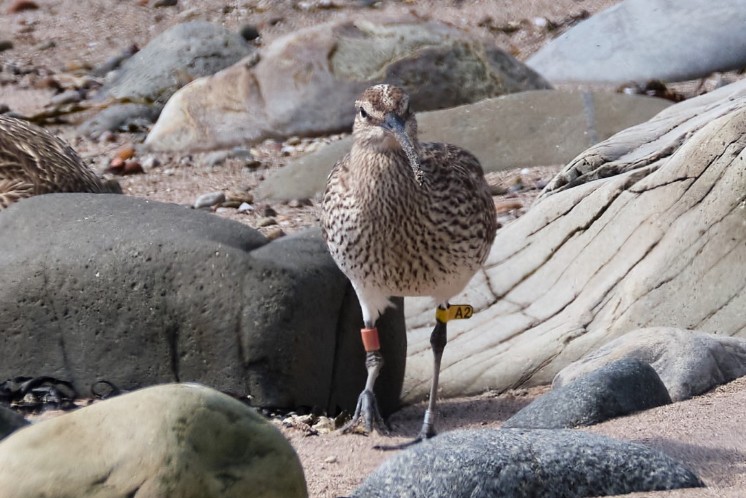Whimbrel A2 on Arran in 2023
Reports

Whimbrel is one of the most widespread of the curlews. With four subspecies, it breeds across much of the sub arctic including North America, Asia, and Europe as far south as Scotland. In Scotland the breeding strongholds are on Shetland, Orkney and the Outer Hebrides with smaller populations on the mainland at Sutherland and Caithness. In other parts of Scotland, it is a widespread passage migrant mainly in the west in spring and east in autumn.
Whimbrel winters on coasts in Africa, South America, south Asia into Australasia and southern North America. On Arran, it is during the migration from the sub arctic to the west coast of Africa in the spring that it is most likely to be seen. Most of the records on Arran occur between mid-April and the end of May.
Whimbrel winters on coasts in Africa, South America, south Asia into Australasia and southern North America. On Arran, it is during the migration from the sub arctic to the west coast of Africa in the spring that it is most likely to be seen. Most of the records on Arran occur between mid-April and the end of May.
To try to find out more about the Whimbrel moving through Arran, members of the Clyde Ringing Group, under license, caught and fitted Whimbrel with coloured rings and little leg flags. On 30 April 2017 on a shore on the south of Arran, a Whimbrel was fitted with the leg flag A2 and released to head onto its breeding ground further north and then winter in Africa. The following spring A2 was back on the same shore and every spring since, it has been seen on Arran in the same area in virtually the same week for the last six years. This is a remarkable story. In 2022 it re-fueled for its north bound journey from 26-28 April. Until 2022 there had never been a report of A2 from its breeding ground nor its wintering area. Last winter on 24 November 2022 it was reported wintering on the coast at Bank a’ Arguin, Mauritania in West Africa. This year, after another journey of around two and a half thousand miles, it arrived on Arran on Tuesday 25 April, a day earlier than last year. It was again photographed before heading north.
I wonder if this year there will be a report of a sighting from its breeding ground or a further report from its wintering area. Its return to Arran in the spring of next year will again be eagerly anticipated.